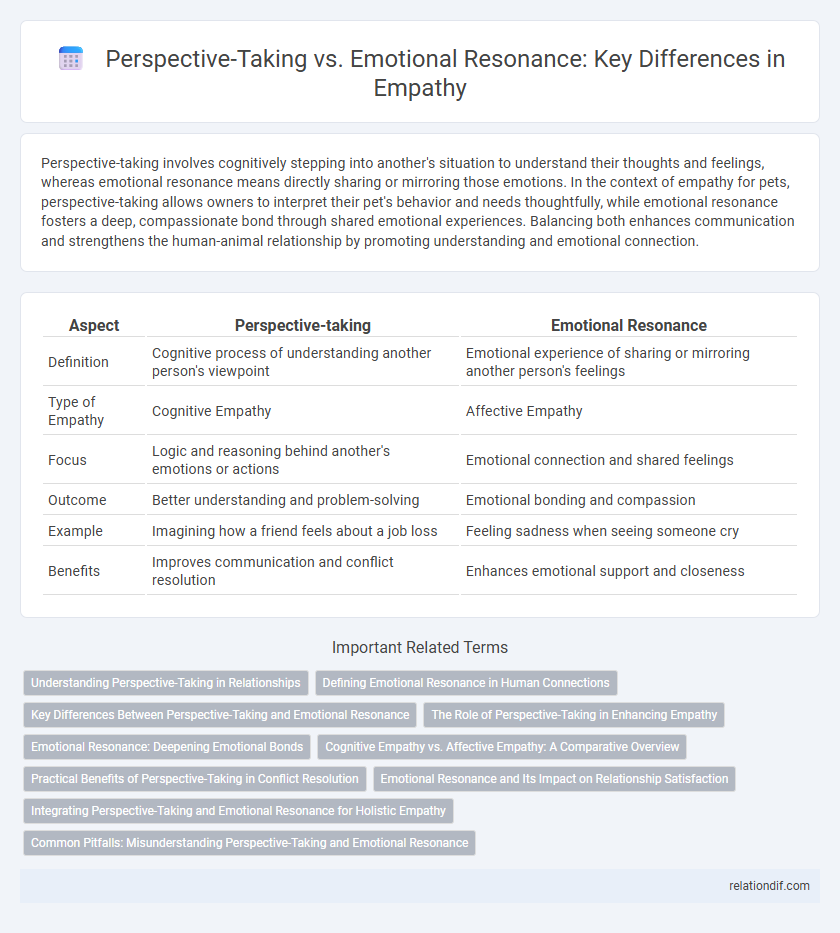Perspective-taking involves cognitively stepping into another's situation to understand their thoughts and feelings, whereas emotional resonance means directly sharing or mirroring those emotions. In the context of empathy for pets, perspective-taking allows owners to interpret their pet's behavior and needs thoughtfully, while emotional resonance fosters a deep, compassionate bond through shared emotional experiences. Balancing both enhances communication and strengthens the human-animal relationship by promoting understanding and emotional connection.
Table of Comparison
| Aspect | Perspective-taking | Emotional Resonance |
|---|---|---|
| Definition | Cognitive process of understanding another person's viewpoint | Emotional experience of sharing or mirroring another person's feelings |
| Type of Empathy | Cognitive Empathy | Affective Empathy |
| Focus | Logic and reasoning behind another's emotions or actions | Emotional connection and shared feelings |
| Outcome | Better understanding and problem-solving | Emotional bonding and compassion |
| Example | Imagining how a friend feels about a job loss | Feeling sadness when seeing someone cry |
| Benefits | Improves communication and conflict resolution | Enhances emotional support and closeness |
Understanding Perspective-Taking in Relationships
Perspective-taking involves cognitively stepping into another person's situation to understand their thoughts and motivations, which enhances communication and conflict resolution in relationships. Emotional resonance, by contrast, entails sharing or mirroring another's feelings, creating emotional connection but sometimes leading to empathic distress. Prioritizing perspective-taking fosters clearer boundaries and more effective support by emphasizing understanding over emotional immersion.
Defining Emotional Resonance in Human Connections
Emotional resonance in human connections refers to the ability to genuinely feel and reflect another person's emotions, creating a deep bond through shared emotional experiences. Unlike perspective-taking, which involves cognitively understanding someone else's viewpoint, emotional resonance emphasizes affective synchronization that fosters empathy and compassion. This visceral connection enhances interpersonal relationships by promoting emotional attunement and mutual understanding at a profound level.
Key Differences Between Perspective-Taking and Emotional Resonance
Perspective-taking involves intellectually understanding another person's viewpoint and thoughts, enabling cognitive empathy. Emotional resonance, by contrast, entails sharing or mirroring another's emotional state, fostering affective empathy. The key difference lies in perspective-taking's focus on cognitive processing versus emotional resonance's emphasis on shared feelings.
The Role of Perspective-Taking in Enhancing Empathy
Perspective-taking plays a critical role in enhancing empathy by allowing individuals to cognitively understand the thoughts and feelings of others, leading to more accurate and compassionate responses. This cognitive process differs from emotional resonance, which involves directly sharing another person's emotional state. By engaging in perspective-taking, people can bridge emotional gaps and foster stronger interpersonal connections through a deeper awareness of diverse experiences.
Emotional Resonance: Deepening Emotional Bonds
Emotional resonance enhances empathy by allowing individuals to deeply share and experience the feelings of others, fostering stronger emotional bonds. This deep connection creates an intuitive understanding that transcends cognitive perspective-taking, leading to more authentic and supportive interpersonal relationships. By fully immersing in another's emotional state, emotional resonance cultivates compassion and trust, essential components for meaningful social interactions.
Cognitive Empathy vs. Affective Empathy: A Comparative Overview
Cognitive empathy involves perspective-taking, allowing individuals to understand another person's thoughts and feelings without necessarily sharing their emotional state. Affective empathy, or emotional resonance, entails directly experiencing the emotions of others, which can lead to deeper emotional connections but may increase emotional burden. Distinguishing between these empathy types enhances emotional intelligence by balancing rational understanding with emotional engagement.
Practical Benefits of Perspective-Taking in Conflict Resolution
Perspective-taking enhances conflict resolution by allowing individuals to understand others' viewpoints objectively, reducing misunderstandings and fostering cooperation. Unlike emotional resonance, which risks emotional overwhelm, perspective-taking promotes clear communication and problem-solving through cognitive empathy. This approach leads to more effective negotiation outcomes and sustained relationships in both personal and professional settings.
Emotional Resonance and Its Impact on Relationship Satisfaction
Emotional resonance, the capacity to deeply feel and mirror another person's emotions, enhances relationship satisfaction by fostering a profound sense of connection and understanding. This empathetic attunement allows partners to respond sensitively to each other's emotional states, reducing conflicts and increasing intimacy. Studies indicate that couples exhibiting high emotional resonance report greater trust, communication quality, and overall relational happiness.
Integrating Perspective-Taking and Emotional Resonance for Holistic Empathy
Integrating perspective-taking and emotional resonance enhances holistic empathy by simultaneously engaging cognitive understanding and affective connection, fostering deeper interpersonal bonds. Perspective-taking allows individuals to intellectually grasp others' experiences while emotional resonance enables sharing and validating those feelings, creating a balanced empathetic response. This synergy improves communication, conflict resolution, and social cohesion across diverse contexts.
Common Pitfalls: Misunderstanding Perspective-Taking and Emotional Resonance
Misunderstanding perspective-taking occurs when individuals confuse it with emotional resonance, leading to inaccurate assumptions about others' feelings. Perspective-taking involves cognitively adopting another's viewpoint, whereas emotional resonance entails sharing or mirroring emotions on an affective level. Common pitfalls include overprojecting one's emotions during perspective-taking, resulting in empathy fatigue or bias.
Perspective-taking vs emotional resonance Infographic

 relationdif.com
relationdif.com